General Lying-In Hospital
85 York Road, Lambeth, SE1 7NJ
Medical dates:
Medical character:
Maternity
On 7th August 1765 Dr John
Leake, a 'man-midwife', proposed to a meeting in Appleby's Tavern in
Parliament Street, Westminster, that a maternity hospital be
established. Its aim would be to provide "Relief
of those Child-bearing Women who are the Wives of poor industrious
Tradesmen or distressed House-keepers and who either from unavoidable
misfortunes or the Expences of maintaining large Families are reduced
to real Want. Also for the reception and immediate relief of
indigent Soldiers' and Sailors' Wives, the former being very numerous
in and about the City of Westminster". For this purpose,
he had already obtained a building lease for a plot of land on the
north side of Westminster Bridge Road.
A charity was set up and fund-raising began. The foundation stone for the hospital was laid on 15th August 1765. However, financial problems resulted in the central building have to be mortgaged before it had been completed.
The Hospital opened in April 1767 as the Westminster New Lying-In Hospital (despite being located in the Borough of Lambeth).
In 1818 it was renamed the General Lying-In Hospital. With the leases of the land on which the building stood due to explite in 1821 and 1825, the Hospital governors decided to move to a new site. They acquired a building lease on an 0.15 hectare piece of land a short distance away - on the east side of York Road, opposite County Hall - on which to build a new hospital.
The new building opened in September 1828, with a 100-ft (30 metres) frontage along York Road. It had four storeys, including a semi-basement, and had cost about £3,000. The first baby was delivered on 22nd September 1828.
By this time unmarried women were also admitted, the governors having received many representations of the severe hardships and distress experienced by these women who, friendless and overwhelmed by shame, were tempted to kill themselves or their babies. Unmarried mothers were only admitted once, and to separate wards from the married women. The patients - both married and unmarried women from across London - gained admittance once Lambeth's church wardens had ensured they would not be a burden on the parish.
In 1830 the Hospital was incorporated by Royal Charter. As well as female midwives, the physicians were allowed to take male pupils who had previously attended two courses of midwifery lectures. The students boarded at the Hospital.
Expectant mothers were also attended in their homes and, by 1830, the average annual number of in-patients was 280, and of out-patients 710.
By the 1870s great advances had been made in medical science and the Hospital was in dire need of modernisation, both in terms of its building and in its management. In 1879 a new drainage system was installed and the laundry in the basement converted into storerooms. The building was modernised and extended, with a new ward added. A new storey was added to each wing to accommodate the students attending the newly established Training School for Midwives and Midwifery Nurses. Under the leadership of Joseph Lister, appointed as consulting surgeon in March 1879, the Hospital became the first to practise antiseptic midwifery.
In 1907 the Albany Baths - at No. 83 York Road, adjacent to the Hospital - were acquired for use as a Nurses' Home.
Between 1929 and 1933 the Hospital was extensively rebuilt - it then had 76 beds. A new Out-Patients Department was added. Because of the severe shortage of staff accommodation, the Albany Baths were demolished and a new Nurses' Home built on their site. The red brick building contained 74 bedrooms and bedsitting rooms, decorated in various pastel shades, on the five upper floors, and a Welfare Centre on the ground floor and basement. A Lecture Hall and Museum were also provided. Queen Mary, Patron of the Hospital, opened the new Out-Patients Department, Mothers' and Children's Welfare Centre and Nurses' Home on 6th March 1933.
In 1939, through WW2, the Hospital was evacuated to Diocesan House (later renamed Verulam House) in St Albans, although the Out-Patients Department continued to operate. The building sustained some bomb damage, but the wards re-opened in 1946 when the Hospital became the maternity wing of St Thomas' Hospital.
It closed in 1971.
A charity was set up and fund-raising began. The foundation stone for the hospital was laid on 15th August 1765. However, financial problems resulted in the central building have to be mortgaged before it had been completed.
The Hospital opened in April 1767 as the Westminster New Lying-In Hospital (despite being located in the Borough of Lambeth).
In 1818 it was renamed the General Lying-In Hospital. With the leases of the land on which the building stood due to explite in 1821 and 1825, the Hospital governors decided to move to a new site. They acquired a building lease on an 0.15 hectare piece of land a short distance away - on the east side of York Road, opposite County Hall - on which to build a new hospital.
The new building opened in September 1828, with a 100-ft (30 metres) frontage along York Road. It had four storeys, including a semi-basement, and had cost about £3,000. The first baby was delivered on 22nd September 1828.
By this time unmarried women were also admitted, the governors having received many representations of the severe hardships and distress experienced by these women who, friendless and overwhelmed by shame, were tempted to kill themselves or their babies. Unmarried mothers were only admitted once, and to separate wards from the married women. The patients - both married and unmarried women from across London - gained admittance once Lambeth's church wardens had ensured they would not be a burden on the parish.
In 1830 the Hospital was incorporated by Royal Charter. As well as female midwives, the physicians were allowed to take male pupils who had previously attended two courses of midwifery lectures. The students boarded at the Hospital.
Expectant mothers were also attended in their homes and, by 1830, the average annual number of in-patients was 280, and of out-patients 710.
By the 1870s great advances had been made in medical science and the Hospital was in dire need of modernisation, both in terms of its building and in its management. In 1879 a new drainage system was installed and the laundry in the basement converted into storerooms. The building was modernised and extended, with a new ward added. A new storey was added to each wing to accommodate the students attending the newly established Training School for Midwives and Midwifery Nurses. Under the leadership of Joseph Lister, appointed as consulting surgeon in March 1879, the Hospital became the first to practise antiseptic midwifery.
In 1907 the Albany Baths - at No. 83 York Road, adjacent to the Hospital - were acquired for use as a Nurses' Home.
Between 1929 and 1933 the Hospital was extensively rebuilt - it then had 76 beds. A new Out-Patients Department was added. Because of the severe shortage of staff accommodation, the Albany Baths were demolished and a new Nurses' Home built on their site. The red brick building contained 74 bedrooms and bedsitting rooms, decorated in various pastel shades, on the five upper floors, and a Welfare Centre on the ground floor and basement. A Lecture Hall and Museum were also provided. Queen Mary, Patron of the Hospital, opened the new Out-Patients Department, Mothers' and Children's Welfare Centre and Nurses' Home on 6th March 1933.
In 1939, through WW2, the Hospital was evacuated to Diocesan House (later renamed Verulam House) in St Albans, although the Out-Patients Department continued to operate. The building sustained some bomb damage, but the wards re-opened in 1946 when the Hospital became the maternity wing of St Thomas' Hospital.
It closed in 1971.
Present status (December 2007)
The Grade II building became derelict and eventually appeared on English Heritage's 'Buildings at Risk' register.
Following a £4.27m restoration in 2003, it then became home to Guy's and St Thomas' NHS Foundation Trust's procurement, training and IT training departments.
The decision to sell the building in 2006 after such an expensive refurbishment angered local residents, but the Trust defended its position as "having a duty to make the most efficient and effective use of NHS resources".
The building was sold in December 2007.
Update: October 2014
The 1930s Nurses' Home has been demolished while the former Hospital is now part of the Premier Inn Waterloo hotel.
The Grade II building became derelict and eventually appeared on English Heritage's 'Buildings at Risk' register.
Following a £4.27m restoration in 2003, it then became home to Guy's and St Thomas' NHS Foundation Trust's procurement, training and IT training departments.
The decision to sell the building in 2006 after such an expensive refurbishment angered local residents, but the Trust defended its position as "having a duty to make the most efficient and effective use of NHS resources".
The building was sold in December 2007.
Update: October 2014
The 1930s Nurses' Home has been demolished while the former Hospital is now part of the Premier Inn Waterloo hotel.
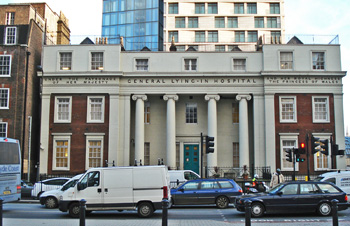
The newly refurbished General Lying-In Hospital is for sale in 2007 (above and below). The red brick Nurses' Home is just visible on the left of the image.
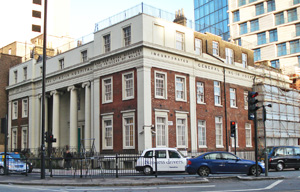
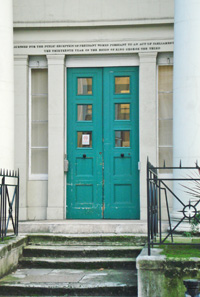
The inscription above the doorway reads "Licensed for the public reception of pregnant women pursuant to an Act of Parliament the thirteenth year of the reign of King George the Third".
Update: July 2012
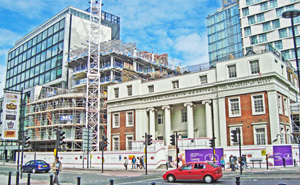
The Nurses' Home adjacent to the Hospital has been demolished and building work is progressing on the new Premier Inn (above and below).
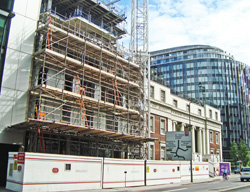
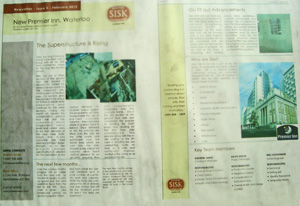
An information sheet giving details on the new hotel being built.
Update: April 2014
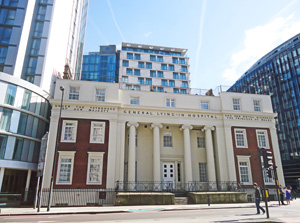
The Grade II listed building is now part of the Premier Inn hotel, seen on the left of the image (above and below).
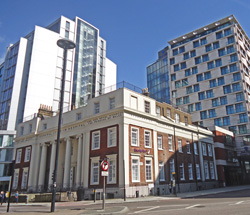
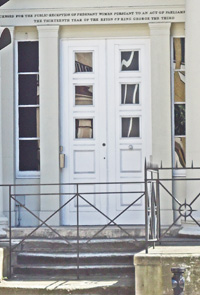
The front door has been painted white, but the inscription above remains.
(Author unstated) 1933 The Queen's interest in midwifery. British Journal of Nursing Supplement. The Midwife (March), 88.
Rhodes P 1977 Dr John Leake's Hospital - A History of the General Lying-In Hospital, York Road, Lambeth 1765-1971. London, Davis-Poynter.
Ryan T 1885 The History of Queen Charlotte's Lying-in Hospital: from its Foundation in 1753 to the Present Time, with an Account of its Objects and Present State. London, Queen Charlotte's Hospital.
http://comestepbackintime.wordpress.com
http://landmark.lambeth.gov.uk
https://familysearch.co.uk
www.aim25.ac.uk
www.bdonline.co.uk
www.british-history.ac.uk
www.britishlistedbuildings.co.uk
www.building.co.uk
www.cityoflondon.gov.uk
www.geograph.org.uk
www.london-se1.co.uk/news/view/2525
www.skyscrapernews.com
Return to home page